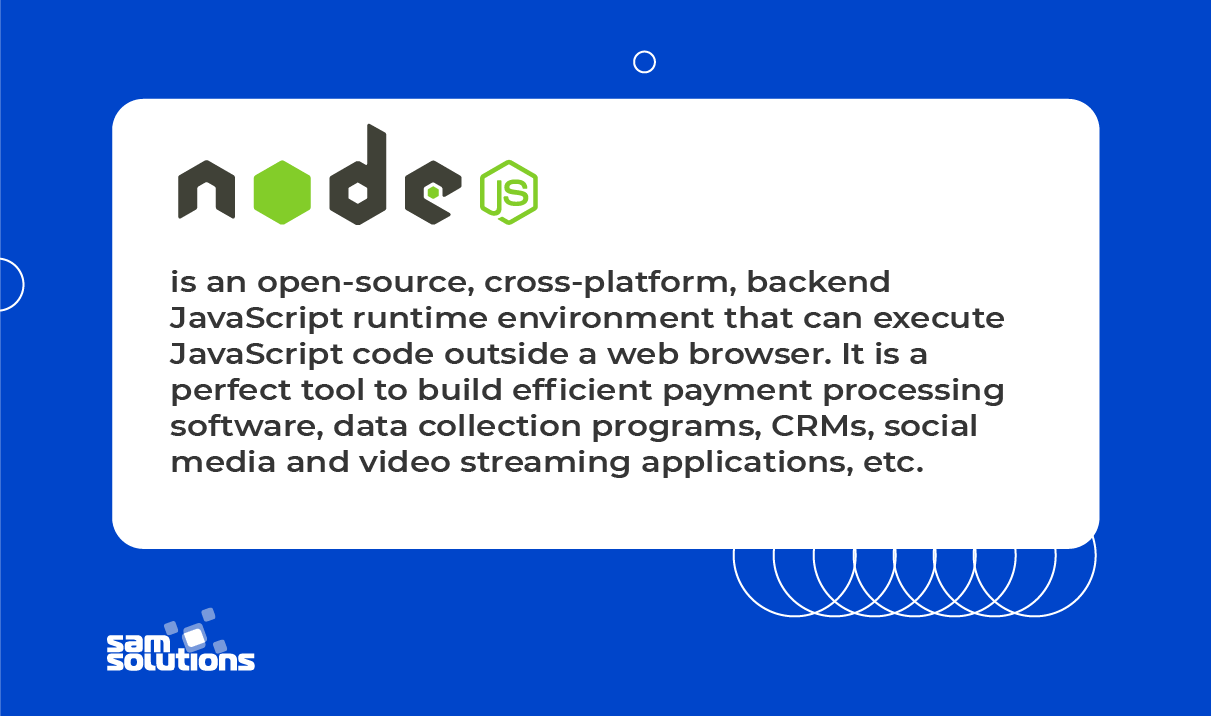JavaScript has gained the popularity as the most widespread programming language for working with the client side of applications. Thanks to its abundant technical features and flexible nature, it has won the hearts of many developers. Lots of frontend frameworks like Vue, Angular, etc. exist to ease and enhance the everyday work of JS experts.
Moreover, JavaScript is not only suitable for frontend; its robust functionalities can also boost the server side with effective backend engineering. The two instruments that help developers utilize the backend potential of JavaScript are TypeScript and Node.js. Read on to learn what their differences and main features are.
Overview
TypeScript was created with the aim of expanding the technical abilities of JavaScript. It offers static typing and helps discover the problems with coding prior to their appearance in the runtime environment. Node.js is an open-source development framework implemented for JavaScript execution on the server side. JavaScript developers utilize it to simplify the working processes and reduce expenditures on making highly-functional applications. With this technology, frontend developers do not have to master additional language to perform full stack development. In our article, we will consider the peculiarities of both technologies in more detail.
What Is TypeScript?

TypeScript is a programming language that adds static typing, compiling and OOP to JavaScript. As a JavaScript’s super set, TypeScript is based on JS, so any TypeScript coding can be transformed into ordinary JavaScript with the help of compiler. Firstly, JavaScript was destined to become a robust development language for client side. Nevertheless, in the course of time, software developers discovered that JavaScript can be used for server side as well.
The language was intensely enhanced with new features, but with the evolution and upgrading it also became obvious that JS turned out to be increasingly complicated and heavy-load. That’s why TypeScript emerged. Unlike JavaScript, it is best suited for large-scale projects with global dispersed teams. It offers a number of valuable benefits that can make the development process more efficient, such as high performance and early bug identification at the compilation stage.
What Is Node.js?

Node.js is a robust free JavaScript-oriented multi-platform runtime environment. It is a great instrument for the development of online chats, video streaming websites, SPAs and APIs, social media and messaging applications, multiplayer games, Internet of Things, embedded systems, real-time collaborative tools, etc. Thanks to its versatility, asynchronicity and event-driven characteristics, it is often preferred by the developers over other similar options.
Among its other major advantages one can find high speed, scalability and efficient performance. However, it is not perfect for CPU-intensive applications. Nodejs is predicted to become more widespread, as according to the statistics, it has shown a stable increase in popularity over the recent time.
Pros and Cons of TypeScript
Among the most prominent advantages of TypeScript one can find quick and transparent identification of code bugs at early stages of the project. Besides, when the software developers specify types, they stay unaltered and have exclusively definite values. Due to this predictability, TypeScript is considered to be a stable and reliable language. As types always function as they should according to the way they were specified, no unexpected emergencies happen. What is more, the language is extremely easy to read and comprehend, as the developer’s intention in the coding is clearly visible to the fellow teammates. This increased level of transparency is achieved thanks to the static typing and adding annotations.
In TypeScript, it is possible to perform the effective application upgrading, which doesn’t require adjustments in the app functioning. The system can catch errors on its own and notify the users if needed, which speeds up the upgrading. With TypeScript, developers can create well-structured code which is organized in a way that assists project growth. This being said, developers can scale the coding when necessary when the project scope expands beyond the initial needs.
Achieve digital transformation with custom software delivered by SaM Solutions’ seasoned engineers.
Regarding the most significant disadvantages of TypeScript, software developers usually speak of lengthy code that demands more time and monetary investments, which is not always feasible given the project scope and specific customer requirements. Although TypeScript is often considered to be easy to master for the developers who already possess background knowledge of JavaScript, developers still should devote some time and effort to study it. For small-scale projects, TypeScript may be not the best choice. In that case, it is better to resort to JavaScript. But before judging TypeScript too strictly, firstly one should be aware of constant TypeScript’s evolution, as the language doesn’t stay the same during all these years, but always undergoes transformations to meet the current demands of the modern market and solve the problems that the users may encounter.
All devices that utilize JavaScript can work with TypeScript in a similar way regardless of the platforms and browsers they use. These multi-platform and browser-agnostic nature allows versatile approach as with TypeScript it becomes possible to convert all the code in one go. What is more, TypeScript is supported by an active community of users. With more than 11 million JavaScript developers, the potential number of its adherents is even bigger, while TypeScript is substantially based on JavaScript both syntactically and semantically, making it easy for JavaScript developers to grasp it. Therefore, it is unlikely that businesses that decide to try TypeScript will ever experience lack of the proper technical developers.
Pros and Cons of Node.js
Thanks to Nodejs capacities, developers can create server-side applications with JavaScript. This platform is easy to utilize as it has clear and simple structure, so it’s possible to set it up and start using quickly. Additional advantage is a large number of developers who are eager to constantly contribute to the creation of new Node.js toolkits, databases, etc. in order to improve the instrument. Thanks to event-driven asynchronicity in Node.js, it is possible to handle requests concurrently. Besides, it shares single pieces of coding equally with the server- and client-side. The streaming of large heavy files is also possible with Nodejs. As Nodejs utilizes user-friendly JavaScript language, it is considered to be easy to learn and start working with.
Nevertheless, Node.js has some drawbacks too. Regarding the most noticeable ones, Nodejs developers often mention instability and frequent changes in API. This can lead to multiple issues for developers so they would need additional time to identify and eliminate bugs. Large number of Node.js users can create some problems as well. A plenty of libraries emerged that have not been properly tested before release, and they can cause issues for Node.js software developers in the long run. Another drawback is that Nodejs is not scalable enough. If you decide to use relational databases and Nodejs, you are likely to meet hurdles as well. The association with JavaScript implies the necessity of in-depth expertise in the language, so Node.js is not the best choice for novice developers who have started their careers in the industry.
In IT since 1993, SaM Solutions offers professional custom software development services to clients across all industries.
Nodejs offers the possibility of efficient high-performant development in comparison with such languages as Java, PHP, etc. The main peculiarity of Nodejs in this regard is its speed of development. Another huge benefit of Nodejs is its ability to cache data, i.e. to provide safe data storage on the client’s machine with quick access to it when necessary. It becomes especially beneficial when you own a website that has high traffic, as Node.js makes the work on it notably faster. If there is a possibility to cache the files, servers don’t have to send requests to databases as often as they need these files. As a result, the performance of websites is better as the response time is decreased, which influences customer experience in a positive way.
What is more, the projects that are powered by Node.js are really cost-effective as there is no need to find developers in many languages, the knowledge of JavaScript is sufficient both for frontend and backend development. This approach may be a perfect choice when you want to improve collaborative efforts of the teams on the project and save resources. Besides, thanks to fastness of Node.js, the programs are produced in comparatively quicker period.

Difference between TypeScript and Node.js
When we consider these two options, and have to choose, which one is the best for your enterprise, we should evaluate each of them regarding numerous markers. We have made a table to compare them and make the choice easier for you. First of all, bear in mind that there exist no solution equal for all the companies, and pay attention to the peculiarities of your enterprise. Next, identify the needs of your company and which technology will better meet all the demands you have.
| Feature | TypeScript | Node.js |
| Term | A programming language. As a subset of JavaScript, it was initially designed to resolve the problems JavaScript had. It is great for the development of large-scale applications. | An open-source, multi-platform, backend JavaScript runtime environment. It can execute JS coding outside browsers and was created to develop highly-scalable applications. |
| Year of creation | 2012 | 2009 |
| Examples of implementation | Large-scale projects with huge codebase, web pages with interactive and dynamic visuals, web applications, websites, server applications, web servers, games, mobile applications, embedded software, robotics, etc. | Backend APIs, eCommerce, crowdfunding, IoT, payment processing, browser games, web applications, websites, data collection programs, mobile apps, real-time applications, social media applications, CRMs, video streaming applications, etc. |
| Major advantages |
|
|
| Major disadvantages |
|
|
| Companies that use it | Slack, Walmart, Accenture, Trello, CircleCI | Netflix, Reddit, Tumblr, PayPal, AliExpress |
Conclusion
Both TypeScript and Node.js are noteworthy modern technologies based on JavaScript. Their nature is essentially different, as the first one is the language, and another one is the runtime environment. When deciding to resort to any one of them, the main thing you should pay attention to is the specifics of your project: for example, Nodejs is proved to be really great for payment processing systems and IoT industry. TypeScript, in its turn, is great for creating web pages abundant with interactive and dynamic imagery.
Besides, TypeScript in combination with Nodejs can show outstanding results. So you can enjoy the benefits of both instruments at the same time. If you have any questions regarding which technology to choose, please don’t hesitate to contact SaM Solutions. Developers at our company would be glad to give valuable advice and help with your projects.



















 The Latest 15 Information Technology Trends in 2024
The Latest 15 Information Technology Trends in 2024 Top 10 Embedded Software Development Tools
Top 10 Embedded Software Development Tools IaaS vs. PaaS vs. SaaS: What’s the Difference?
IaaS vs. PaaS vs. SaaS: What’s the Difference? IoT Development: Top 15 Internet of Things Tools and Platforms in 2024
IoT Development: Top 15 Internet of Things Tools and Platforms in 2024 10 Examples of Predictive Analytics
10 Examples of Predictive Analytics











![[Tech Talk] What Developers Should Know About SQL Optimization, Part 1: Fundamentals](https://www.sam-solutions.com/blog/wp-content/uploads/fly-images/30279/SQL-video-cover-370x238.webp)